Giochi dell'Oca e di percorso
(by Luigi Ciompi & Adrian Seville)
(by Luigi Ciompi & Adrian Seville)

|
Giochi dell'Oca e di percorso
(by Luigi Ciompi & Adrian Seville) |

|
 |

Torna alla ricerca giochi (back to game search) |
 |
| Pelle (La) del Rinoceronte - Rhino Skin | ||
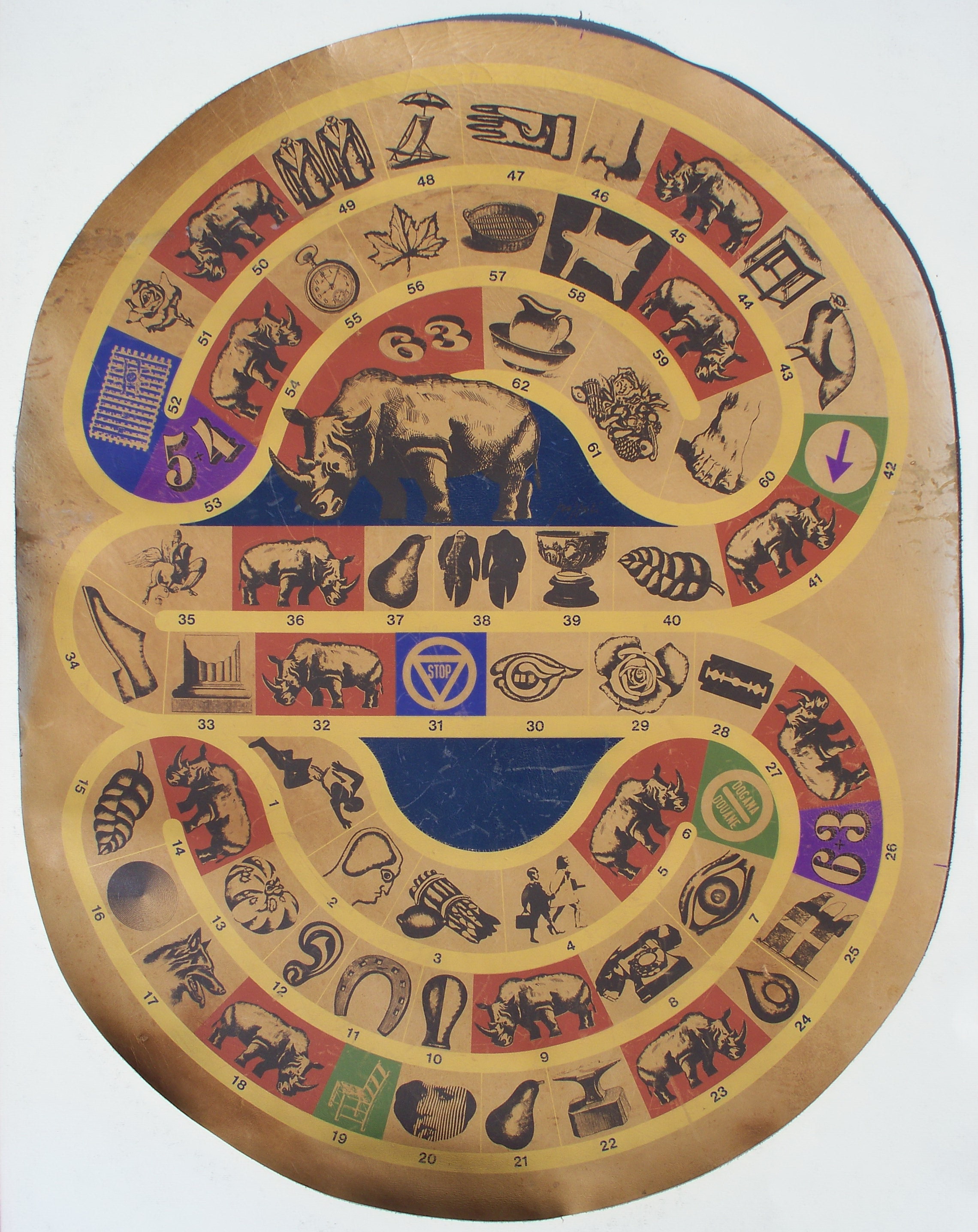 |
Versione stampabile
 |
Invia una segnalazione

|
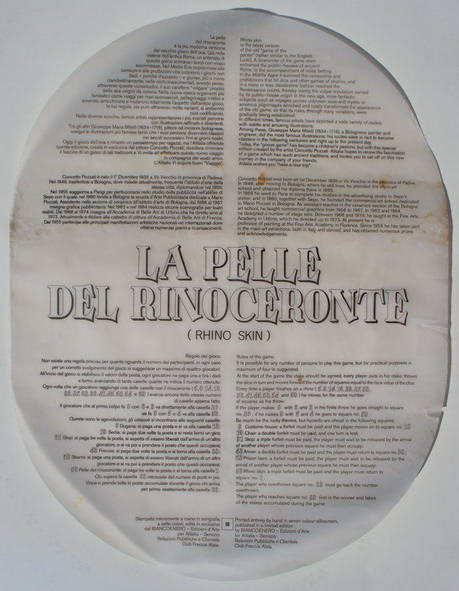 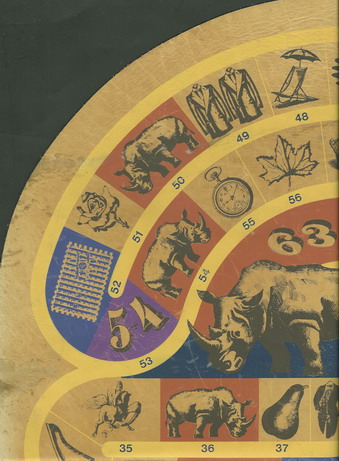 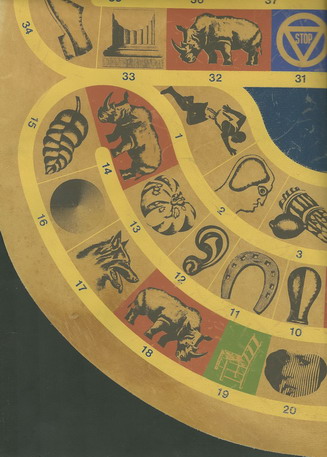 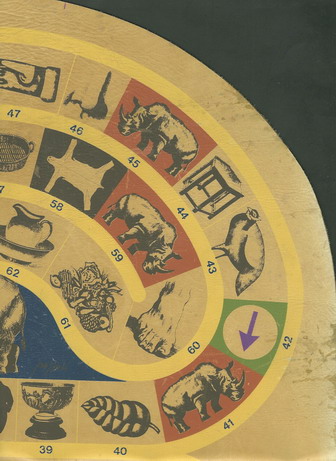 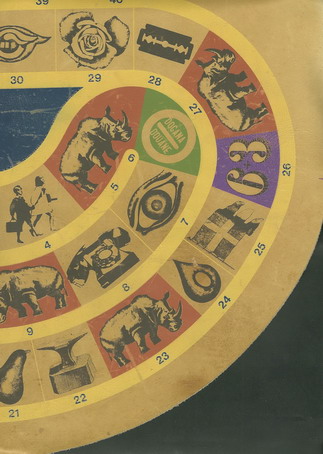 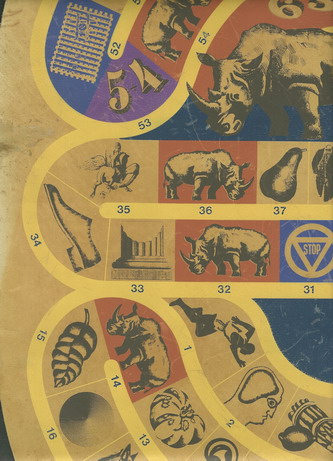 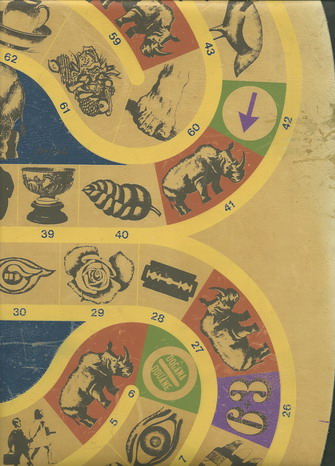 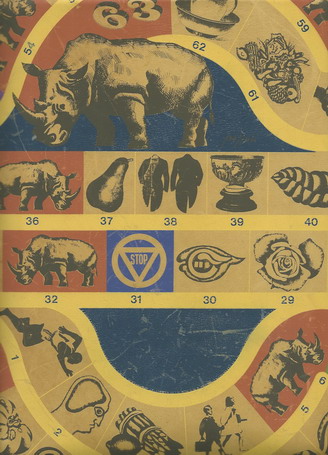 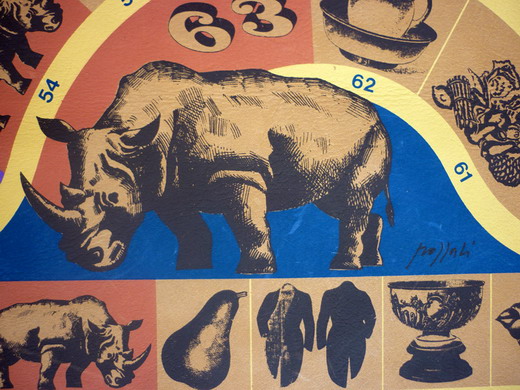  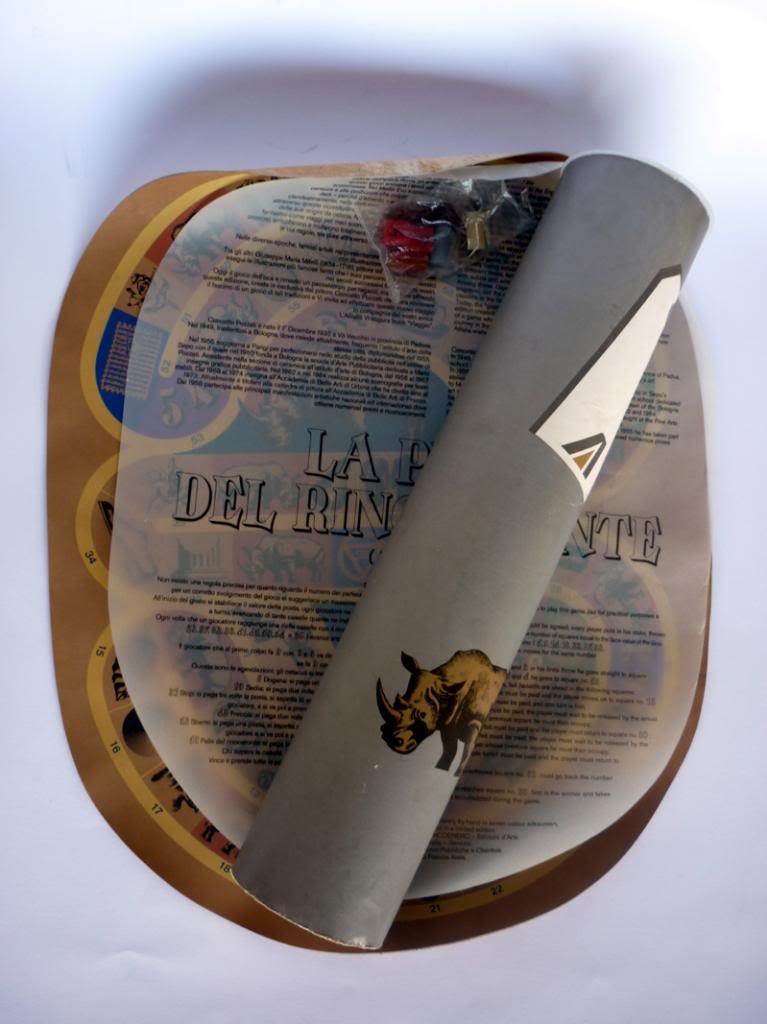 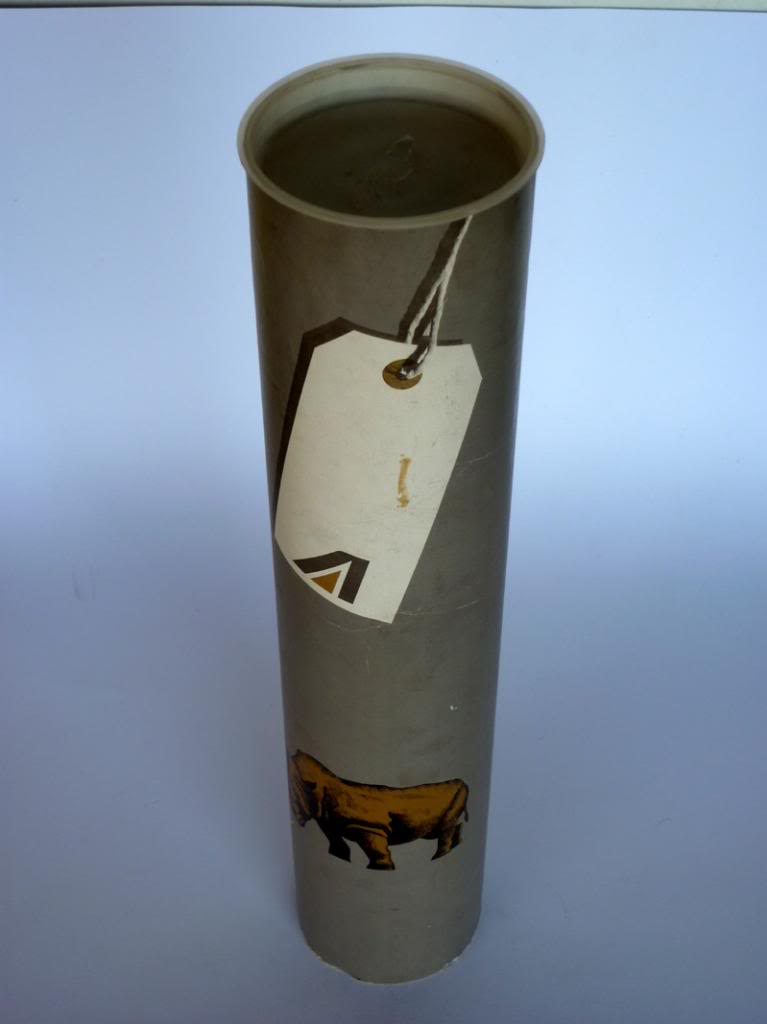 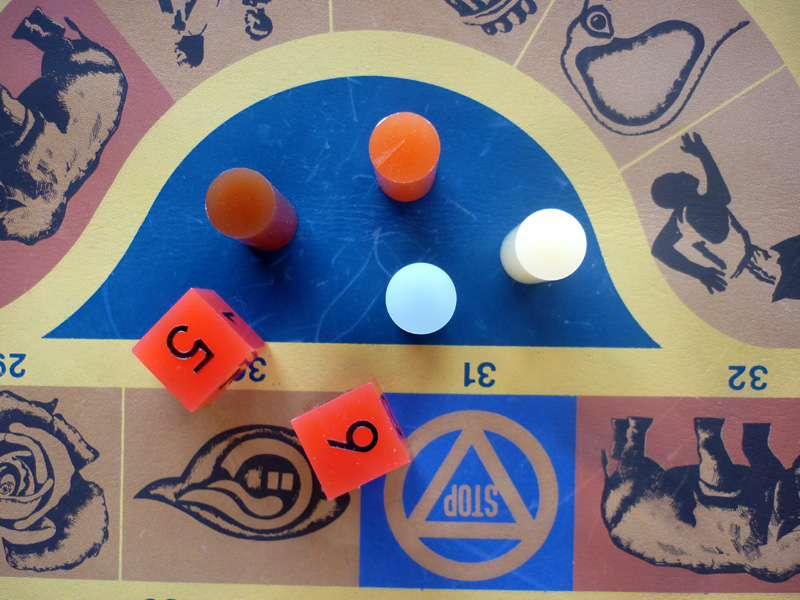 |
primo autore: | Pozzati Concetto |
| secondo autore: | Pozzati Concetto | |
| anno: | 1980/90 | |
| luogo: |
Italia-Milano |
|
| periodo: | XX secolo (?/4) | |
| percorso: | Percorso di 63 caselle numerate | |
| materiale: | pelle | |
| dimensioni: | 580X450 | |
| stampa: | Serigrafia a sette colori | |
| luogo acquisto: | Italia-Milano | |
| data acquisto: | ||
| dimensioni confezione: | ||
| numero caselle: | 63 | |
| categoria: | Oca | |
| tipo di gioco: | Gioco oca variante | |
| editore: | Alitalia | |
| stampatore: | Biancoenero-Edizioni d'Arte per Alitalia | |
| proprietario: | Collezione L. Ciompi | |
| autore delle foto: | L. Ciompi | |
| numero di catalogo: | 2255 | |
| descrizione: |
Gioco di 63 caselle numerate stampato a mano su pelle in serigrafia a sette colori. REGOLE: allegate e stampate su carta pergamena (vedi sotto). CASELLE: mute. "La pelle del rinoceronte è la più moderna versione del vecchio gioco dell'oca. Già nelle osterie dell'antica Roma, un antenato di questo gioco animava i tavoli con vivaci scommesse. Nel Medio Evo sopravvisse alle censure e alle proibizioni che colpirono i giochi con dadi - perché d'azzardo - e giunse, più o meno clandestinamente, nelle corti rinascimentali, avendo perso, attraverso queste vicissitudini, il suo carattere “volgare“ proprio delle sue origini da osteria. Nella nuova epoca argomenti più fantastici come viaggi per mari sconosciuti, pellegrinaggi mistici e amorosi, arricchirono e mutarono totalmente l'aspetto dell’antico gioco, le cui regole, sia pure attraverso molte varianti, si andarono cosi codificando. Nelle diverse epoche, famosi artisti rappresentarono i più svariati percorsi con illustrazioni raffinate e divertenti.Tra gli altri Giuseppe Maria Mitelli (1634-1718), pittore ed incisore bolognese, eseguì le illustrazioni più famose tanto che i suoi percorsi divennero classici nei secoli successivi fino ai giorni nostri. Oggi il gioco dell’oca è rimasto un passatempo per ragazzi, ma l’Alitalia offrendo questa edizione, creata in esclusiva dal pittore Concetto Pozzati, desidera rinnovare il fascino di un gioco di tali tradizioni e Vi invita ad effettuare questo nuovo viaggio in compagnia dei vostri amici. L'Alitalia Vi augura buon “Viaggio” Concetto Pozzati è nato il 1° Dicembre 1935 a Vò Vecchio in provincia di Padova. Nel 1949, trasferitosi a Bologna, dove risiede attualmente, frequenta l'istituto d’arte della stessa città, diplomandosi nel 1955. Nel 1955 soggiorna a Parigi per perfezionarsi nello studio della pubblicità nell’atélier di Sepo con il quale nel 1960 fonda a Bologna la scuola d’Arte Pubblicitaria dedicata a Mario Pozzati. Assistente nella sezione di ceramica all'istituto d’arte di Bologna, dal 1956 al 1967 insegna grafica pubblicitaria. Nel 1962 e nel 1964 realizza alcune Scenografie per teatri stabili. Dal 1968 al 1974 insegna all'Accademia di Belle Arti di Urbino che ha diretto sino al 1973. Attualmente è titolare alla cattedra di pittura all'Accademia di Belle Arti di Firenze. Dal 1955 partecipa alle principali manifestazioni nazionali ed internazionali dove ottiene numerosi premi e riconoscimenti. Regole del gioco. Non esiste una regola precisa per quanto riguarda il numero dei partecipanti, in ogni caso per un corretto svolgimento del gioco si suggerisce un massimo di quattro giocatori. All’inizio del gioco si stabilisce il valore della posta, ogni giocatore ne paga una e tira i dadi a turno, avanzando di tante caselle quante ne indica il numero ottenuto. Ogni volta che un giocatore raggiunge una delle caselle con il rinoceronte (5, 9, 14, 18, 23, 27, 32, 36, 41, 45, 50, 54 e 59) avanza ancora dello stesso numero di caselle appena fatto. Il giocatore che al primo colpo fa 9 con 6 e 3 va direttamente alla casella 26; se fa 9 con 6 e 3 va alla casella 53. Queste sono le agevolazioni; gli ostacoli si incontrano alle seguenti caselle: 6 Dogana: si paga una posta e si va alla casella 12; 19 Sedia: si paga due volte la posta e si resta fermi un giro; 31 Stop: si paga tre volte la posta, si aspetta di essere liberati dall'arrivo di un altro giocatore, e si va poi a prendere il posto che questi occupava; 42 Freccia: si paga due volte la posta e si torna alla casella 30; 52 Sbarre: si paga una posta, si aspetta di essere liberati dall'arrivo di un altro giocatore e si va poi a prendere il posto che questi occupava; 58 Pelle del rinoceronte: si paga tre volte la posta e si torna alla casella 1. Chi supera la casella 63 retrocede del numero di punti in più. Vince e prende tutte le poste accumulate durante il gioco chi arriva per primo esattamente alla casella 63. Rhino skin is the latest version of the old “game of the goose" (rather similar to the English Ludo). A forerunner of the game even enlivened the public-houses of ancient Rome, to the accompaniment of noisy betting. In the Middle Ages it survived the censorship and prohibitions that hit dice and other games of chance, and in a more or less clandestine fashion reached the Renaissance courts, thereby losing the vulgar reputation earned by its public-house origin. In the new age, more fantastic subjects such as voyages across unknown seas and mystic or amorous pilgrimages enriched and totally transformed the appearance of the old game, so that its rules, through many variations, were gradually being established. In different times, famous artists have depicted a wide variety of routes, with subtle and amusing illustrations. Among these, Giuseppe Maria Mitelli (1634-1718), a Bolognese painter and engraver, did the most famous illustrations; his routes were in fact to become classics in the following centuries and right up to the present day. Today, the “goose game" has become a children’s pastime, but with this special edition created by the artist Concetto Pozzati Alitalia hopes to renew the fascination of a game which has such ancient traditions, and invites you to set off on this new journey in the company of your friends. Alitalia wishes you “have a nice trip". Concetto Pozzati was born on 1st December 1935 in Vò Vecchio in the province of Padua. In 1949, after moving to Bologna, where he still lives, he attended the city’s art school and obtained his diploma there in 1955. In 1955 he went to Paris to complete his studies in the advertising studio in Sepo’s atelier, and in 1960, together with Sepo, he founded the commercial art school dedicated to Mario Pozzati in Bologna. As assistant teacher in the ceramics section of the Bologna art school, he taught commercial graphics from 1956 to 1967. In 1962 and 1964, he designed a number of stage sets. Between 1968 and 1974, he taught at the Fine Arts Academy in Urbino, which he directed up to 1973. At present he is professor of painting at the Fine Arts Academy in Florence. Since 1955 he has taken part in the main art exhibitions, both in Italy and abroad, and has obtained numerous prizes and acknowledgements. Rules of the game. It is possible for any number of persons to play this game, but for practical purposes a maximum of four is suggested.At the start of the game the stake should be agreed, every player puts in his stake, throws the dice in turn and moves forward the number of squares equal to the face value of the dice. Every time a player finishes on a rhino (5, 9, 14, 18, 23, 27, 32, 36, 41, 45, 50, 54 and 59) he moves for the same number of squares as his throw. If the player makes 9 with 6 and 3 in his firsts throw he goes straight to square no. 26; if he makes 9 with 5 and 4 he goes to square no. 53. So much for the lucky theows, but hazards are ahead in the following squares: 6 Customs house: a forfeit must be paid and the player moves on to square no. 12; 19 Chair: a double forfeit must be paid, and one turn is lost; 31 Stop: a triple forfeit must be paid, the player must wait to be released by the arrival of another player whose previous square he must then occupy; 42 Arrow: a double forfeit must be paid and the player must return to square no. 30; 52 Prison bars: a forfeit must be paid, the player must wait to be released by the arrival of another player whose previous square he must then occupy; 58 Rhino skin: a triple forfeit must be paid and the player must return to square no. 1. The player who overthrows square no. 63 must go back the number overthrown. ` The player who reaches square no. 63 first is the winner and takes all the stakes accumulated during the game. |
|
| bibliografia: | ||
Vai alla ricerca giochi Vai all'elenco autori